ISSN ONLINE(2278-8875) PRINT (2320-3765)
ISSN ONLINE(2278-8875) PRINT (2320-3765)
G.Sukant1, N.Jayalakshmi2
|
| Related article at Pubmed, Scholar Google |
Visit for more related articles at International Journal of Advanced Research in Electrical, Electronics and Instrumentation Engineering
The variable-speed ac motor drive systems used in home electrical appliances are required to have power factor correction circuits. The primary goal is to achieve the reduction of harmonic contamination in the source side and the improvement of transmission efficiency. A new power factor correction method using an inverter-driven interior permanent magnet motor is proposed here. The proposed system realizes the high power factor of a single-phase diode rectifier by using a three-phase pulsewidth modulation inverter and an IPM motor. The inverter has two functions. It regulates the velocity of the IPM motor and it controls the source-side-current waveform by regulating d-q axis current synchronous with input voltage. High power-factor operation is obtained at the source side by regulating the inverter output power for the single-phase to three-phase converter with the reduction of size, weight and power loss of the circuit. Thus, an improved power factor can be achieved by the proposed control method higher than that of the conventional control methods.
Keywords |
| Interior permanent magnet synchronous motor drive, inverter, power factor correction. |
I.INTRODUCTION |
| Variable speed drive is a type of adjustable speed drive used in electro-mechanical drive systems to control ac motor speed and torque by varying motor input frequency and voltage. Variable speed ac motor systems have been applied to home electrical appliances, from the viewpoint of alleviating global environmental problems. In a residential air-conditioner application, controlling the compressor with a variable-speed motor drive would allow overall system optimization that could significantly reduce energy consumption. In order to further conserve energy and resources, power converters equipped with rectifiers are required to achieve high efficiencies and high power factors; they are also required to be small-sized and have low production costs. On the other hand, the demand for improving the power quality of the ac sources has become a great concern because of the rapidly increasing usage of these electrical appliances. |
| In recent years, the variable speed ac motor drive systems used in home electrical appliances are required to have power factor correction circuits. Their primary goal is to achieve the reduction of harmonic contamination in the source side and the improvement of transmission efficiency. The purpose of it is to minimize the unwanted effects introduced by electronic equipments in the power system and utilizing the usable power in the mains. |
| A report in [6], proposes an inverter drive system for an interior permanent magnet synchronous motor and an inverter control strategy to obtain unity power factor operation of the single phase diode rectifier. The unity power factor operation is achieved by dither effect. The additional current controller based on direct torque control improves its input current waveform. For the digital implementation of Direct Torque Control (DTC), very short sampling intervals are necessary which results in high computational burden for the controller. Hence, a control strategy for drives in home appliances with small energy storage in dc-link based on field oriented control with a constant switching frequency can be used. This tends to reduce the size, weight and cost of the drive system. This paper proposes a new variable-speed motor drive system containing a three-phase interior permanent magnet motor. Recently, the Interior Permanent Magnet Synchronous Machine (IPMSM) is getting more popular in applications like traction and machine spindle drives, air conditioning compressors, electrical vehicles, integrated starters/alternators. The reason why the IPMSM is getting more attention is due to its attractive characteristics like high efficiency, high power density, high torque/inertia ratio, wide speed operation range, and free from maintenance. The proposed system consists of a diode rectifier, a three-phase inverter and a small film capacitor. The motor speed is controlled averagely because the three-phase output power includes many ripple synchronous with the single-phase source voltage. The proposed control method is based on inverter output power for a q-axis current controller. Further, in order to improve its power factor, the inverter also regulates the d-axis current synchronous with the input voltage. The effectiveness of the proposed system is compared with open loop circuit without the implementation of controllers. |
II. PROPOSED POWER CONVERTER |
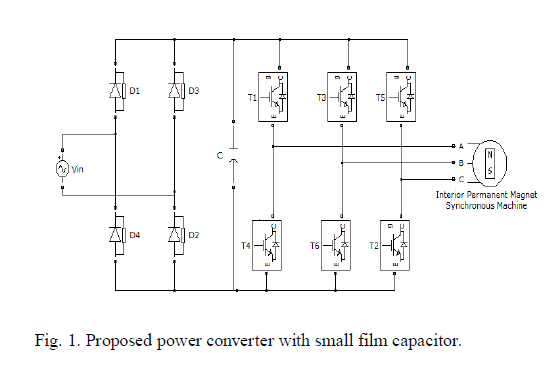 |
| Fig. 1 shows the proposed power converter which consists of single phase diode rectifier, a small-film capacitor across the dc-bus and a three phase voltage source inverter [6]. There are many ripples across the dc-bus voltage which minimizes the capacity of the capacitor. So a small thin film dc-link capacitor only is required in the proposed power converter. These ripples make the input voltage to be synchronous with the input current waveform and hence, the input power factor is improved in the proposed system. The film capacitor is used to absorb the dc-link current ripple due to the pulse width modulation switching of the inverter. |
III. PRINCIPLE OF POWER FACTOR IMPROVEMENT |
 |
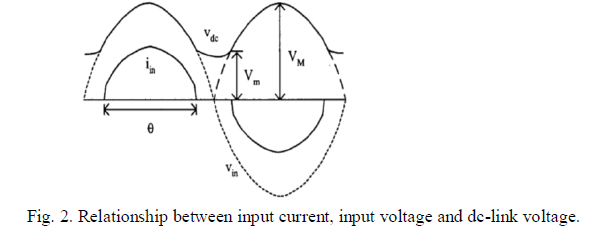 |
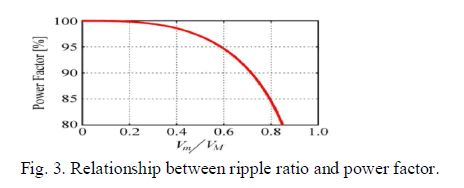 |
 |
 |
IV. INVERTER CONTROL METHOD FOR HIGH POWER FACTOR |
| A. Relationship of input current and load power |
| The principle of the high power factor in circuits with a single-phase source is shown in figure 4. It is assumed that the instantaneous power in the load vibrates with a frequencies twice that of the power supply frequency, for the synchronization with the input voltage [2]. |
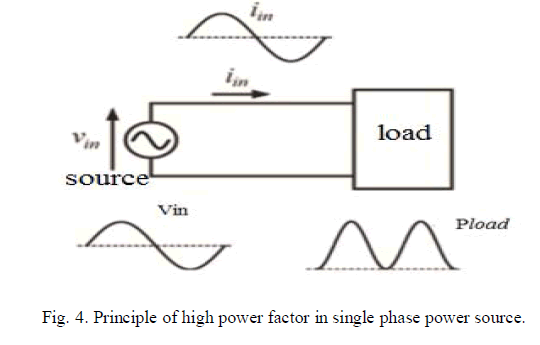 |
 |
 |
| Therefore, to obtain a unity power factor, the instantaneous power of the load connected to the single phase power supply must be controlled to ripple with twice the synchronized input voltage frequency. |
| B.Feedback-control method for inverter output power |
| The relationship between the input power, dc-link capacitor power and inverter output power is given by equation (11). |
 |
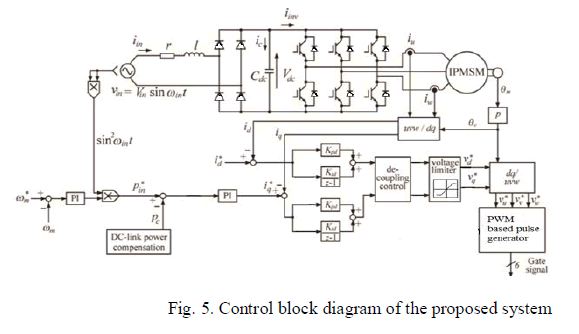 |
 |
| The inverter output power can be obtained from input power and dc-link compensation power using the relation (11). |
| C. d-axis current control synchronous with source voltage |
| A higher power factor is obtained when Vm is smaller and the ripple band of the dc-link voltage is larger. The dc-link voltage increases because of the influence of the electromotive force when the motor speed increases. As a result, the input power factor decreases and the current harmonic components increase. To solve this problem, the approximate value of the d-axis current is given by the flux-weakening control method [4]. The well-known d-axis current control law for the flux-weakening can be applied to the proposed system. |
| In order to control the d-axis current for field- weakening, the d-axis current reference id * is calculated by the equation as follow. |
 |
| D. Control block diagram |
| The fig. 5 shows the control block diagram of the proposed system in closed loop with the implementation of PI controllers. The same motor and system specifications are used as that of the open loop. The speed reference is set to the rated speed (constant value), which is compared with the motor speed and the error value is given to the PI controller. This output is taken as the reference input power. The output of the speed PI controller corresponds to the peak value of the input power required by the system. The d-axis and q-axis current is obtained by parks transformation from the detected phase currents and they are regulated by the PI controller. The regulation of the d-axis current further improves the power factor. The voltage references are obtained by the decoupling control of the outputs of PI controllers. |
| In this, the dc-link voltage varies synchronously with the input power supply. Because of the dc-link ripple voltage, the outputs of both d and q-axis currents in the PI controllers are saturated. As a result, the source current includes harmonic distortion. To improve the input current waveform, a PI control method that accounts for the voltage limitations of the inverter for the d and q-axis currents are done. |
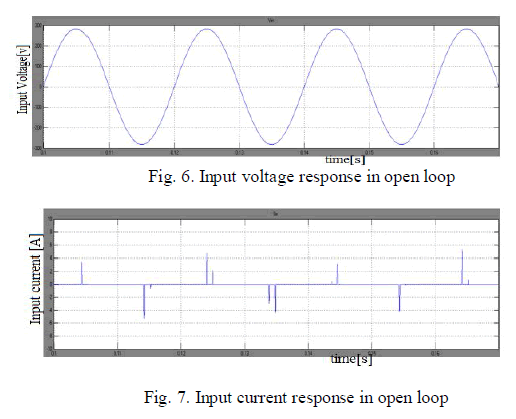 |
V.SIMULATION RESULTS |
| The proposed control strategy is simulated using MATLAB software. The fig. 6 and 7 shows the input voltage and input current response of the simulation for the proposed system. The input current graph shows that the input power factor is too low (the input voltage and input current are out of phase with each other). The fig. 8 and 9 shows the input |
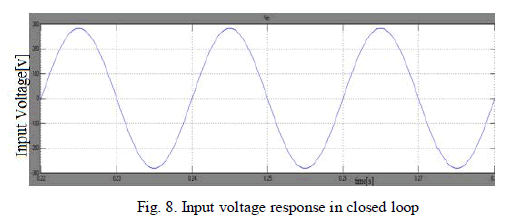 |
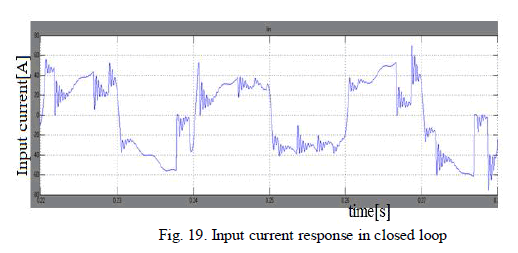 |
| voltage and input current of the proposed simulation circuit in closed loop with the implementation of PI controllers. The input current response is in phase with the input voltage. So the input power factor has been improved in closed loop with the implementation of PI controllers in speed and current feedback when compared to the open loop responses. |
VI. CONCLUSION |
| Thus a new PFC method using an inverter-driven IPM motor is proposed here. This paper also proposes a new inverter control method in order to obtain a high power factor. The power factor of the proposed control method is higher than that of the conventional control methods. The power factor of the proposed control method is calculated to be 0.99 with the implementation of controllers using (7) at rated load condition. The magnitude of current can be achieved by further tuning the PI controller. This proposed method also eliminates the use of large electrolytic capacitor, inductor and high frequency switching device. |
References |
|